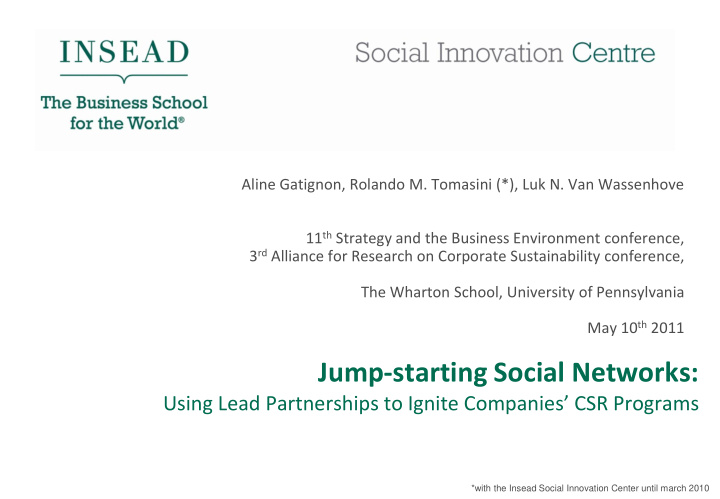



Aline Gatignon, Rolando M. Tomasini (*), Luk N. Van Wassenhove 11 th Strategy and the Business Environment conference, 3 rd Alliance for Research on Corporate Sustainability conference, The Wharton School, University of Pennsylvania May 10 th 2011 Jump-starting Social Networks: Using Lead Partnerships to Ignite Companies’ CSR Programs *with the Insead Social Innovation Center until march 2010
I. CSR partnerships: an emerging trend • CSR through Private-NGO partnerships – much more than $$ • Building networks from scratch – a major challenge Social Innovation Centre
I. CSR partnerships: Research questions Research Question: How do networks form from scratch and develop over time? • RQ A: How do strategic choices and structural forces jointly influence network evolution from scratch? • RQ B: How can organizations design and implement efficient strategies to form networks with partners from very distant sectors? ? Structural Forces e.g.: Gulati & Gargiulo (1999) Efficient Network ? Evolution ? Strategic Choices e.g: Ozcan & Eisenhardt (2009), Hallen & Eisenhardt (forthcoming) Social Innovation Centre
II. Research Design • Inductive theory building from case studies (Eisenhardt & Graebner 2007) • Data: tracking the development of TNT’s CSR network from 2002 -2008 • Interviews with key informants • Internal surveys and employee blogs • Data from external audit of the TNT-WFP partnership • Survey and follow-up interviews (FF) 2002 2003 2004 2005 2006 2008 Phase I: Phase II: convenor networks symbiotic partnership Social Innovation Centre
III. Case Study: 2-phase network evolution Phase II - 2004 Phase II - 2004 Phase II - 2005 Phase II - 2005 Phase I - 2002 Phase II - 2004 Phase I - 2002 Phase I - 2002 Phase I - 2002 Phase II - 2006 Phase II - 2003 Phase II - 2003 Phase II - 2003 Phase II - 2003 Overall Network - 2008 Social Innovation Centre
IV. Analysis of network evolution in light of social network theory + iteration Trust + structural embeddedness + knowledge sharing Absorptive + transfer of collaborative routines capacity + positional embeddedness Partnership 1.0: Collaborative inertia symbiosis + iteration “TNT put a lot of resources and people into the partnership, but when WFP was Partnership 2.0: Network overburdened and unable to respond to TNT’s interest, TNT would turn up at - Network ‘s convenor networks + learning + their offices, which didn’t fit in with the humanitarian agency’s culture and was benefits for structural holes ego incompatible with the emergency situations they faced in the field.” quote from employee “The partnership has brought TNT to a level of trust with the humanitarian community that is really unique ” quote from employee Social Innovation Centre
IV. New Theoretical Propositions Partner Distance Network Exploitation Strategy Social Capital Initial Network Strategy Efficient Network Formation Jump-starting process • P1: Jump-starting and then exploiting social capital are jointly necessary to the efficient shaping of social networks • P2: When networks are formed from scratch and partner distance is great, it is more efficient for actors to invest in a symbiotic partnership with one partner before jointly developing convenor networks, rather than investing in multiple ties at once. Social Innovation Centre
V. Contributions and discussion points • Partner distance determines efficient initial network strategies. • Interaction between structural forces and strategic choices is crucial for network evolution . • Analysis of overall networks is indispensable to understanding network evolution. Future directions: • Generalizability and full range of relevant contingencies • Theory testing Social Innovation Centre
THANK YOU VERY MUCH! Social Innovation Centre
Recommend
More recommend